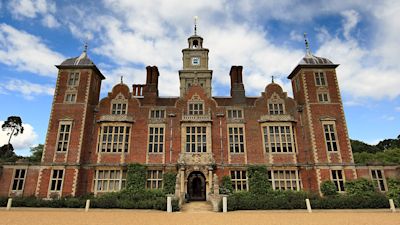Microscopic wasps deployed to take on moths at stately home

Watch a report by ITV News Anglia's Natalie Gray
A new approach to controlling clothes moths is being pioneered by the National Trust to save rare treasures including a tapestry from Catherine the Great.
In a first for a heritage setting, the trial at Blickling Hall, near Aylsham in Norfolk, will deploy tiny parasitic wasps and chemical pheromones in combination to try to prevent the moths damaging carpets, furniture, clothing and other wool and silk objects.
The move comes as the conservation charity reveals the findings from its latest annual pest survey at historic properties, which show that pests and moulds thrived in lockdown with less disturbance from visitors and staff.
Despite careful housekeeping and other measures at Blickling Hall, thought to be the birthplace of Anne Boleyn, the common clothes moth has been hard to control, the National Trust said.
The historic property is home to items including the Peter The Great tapestry, given by Russia’s Catherine the Great to Blickling’s owner in the 1760s, and a state bed with the most complete 18th century examples of a canopy and headcloth, and a counterpane from Queen Anne’s throne canopy.
The trial will deploy Trichogramma evanescens, a wasp just 0.5mm long and barely visible to the human eye, which searches out moth eggs and lays its own eggs inside so that a wasp rather than a moth larva hatches out.
The wasp is the natural enemy of the clothes moth, and not harmful to humans or other animals, the Trust said, adding that once the eggs are laid, the wasps die naturally and disappear into the house dust.
Alongside the wasps, pheromone tabs which spread female moth chemicals that confuse the males and reduce their chance of mating will be used.
Staff at the hall will also keep up their existing regime, which includes maintaining low humidity, daily and rigorous vacuuming of the visitor route, deep cleans of all rooms once a year and monitoring, to defeat the pests.
While wasps and pheromones have been used separately against clothes moths, the Trust believes the two biological controls supplied by company Historyonics, have not been deployed together in a heritage setting before.
Assistant National Conservator Hilary Jarvis said: “We are really hoping this pioneering approach will provide a practical and sustainable method that any of our properties can use to deal with serious infestations.
“Although these are rare, they can sometimes prove immune to our usual, more gentle approaches, with potentially serious results.”
Clothes moths are among the pests that have done well in the last year, according to analysis of data from Trust properties across England, Wales and Northern Ireland for the charity’s annual survey of the problem.
The National Trust said analysis suggests insect numbers rose 11% in 2020 compared to 2019, while many stately homes also reported mould outbreaks due to a lack of activity to drive airflow because they were shut in lockdown.
Ms Jarvis said: “There’s no doubt lockdown suited our resident bugs.
“The relative quiet, darkness and absence of disruption from visitors and staff provided perfect conditions for larvae and adults alike from March onwards,” she said, but added that monitoring through the lockdown helped avert outbreaks.
The mild winter and early spring also pushed pest numbers to highs last year, with many houses inundated with cluster flies in the summer after a lack of harsh frosts.
Silverfish, which feed on books, paper and cotton, were the most commonly found pest in the survey, though numbers dropped 8% in 2020, thought to be due to warm and sunny weather drying out water supplies at critical times.
Webbing clothes moths rose 3%, woolly bears, or carpet beetle larvae, were stable, Australian spider beetles saw numbers rise, though only north of the Midlands, and common booklouse saw a slight rise in 2020 after a sharp increase in 2019.